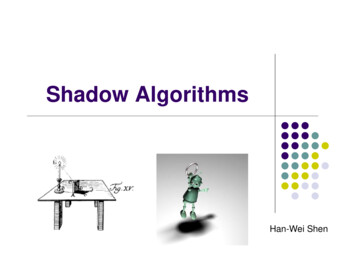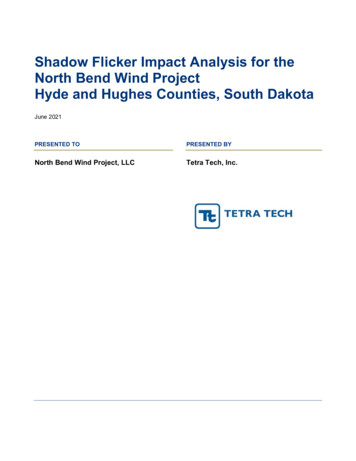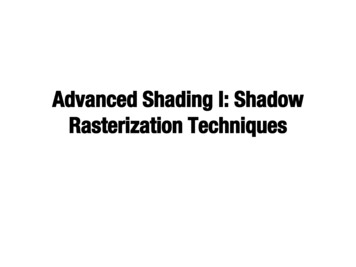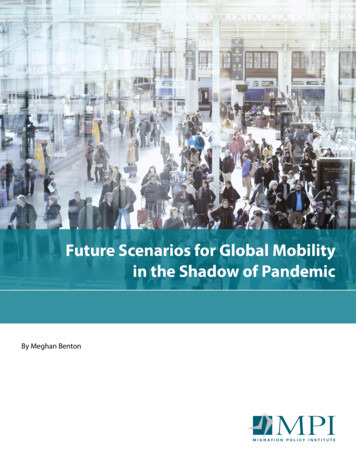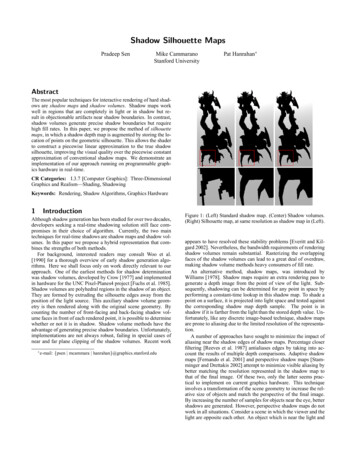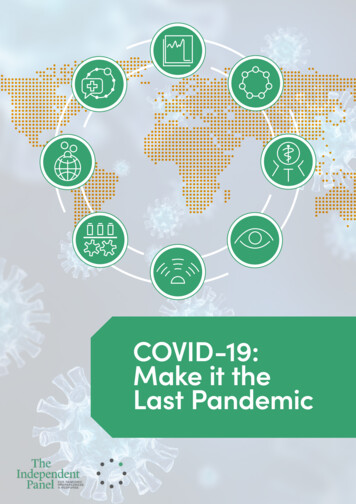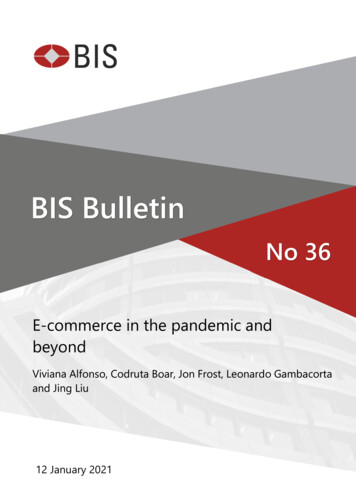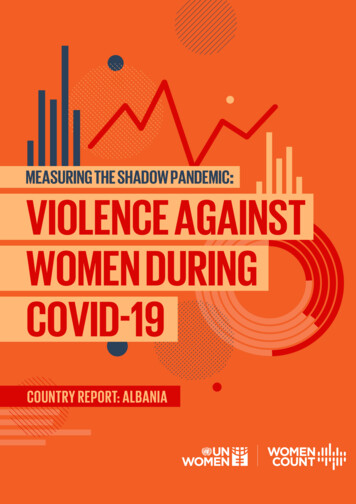
Transcription
MEASURING THE SHADOW PANDEMIC:VIOLENCE AGAINSTWOMEN DURINGCOUNTRY REPORT: ALBANIA
EXECUTIVE SUMMARYMore than half of women in Albania have experienced or know another woman who hasexperienced VAW and said they perceive violence, abuse, or the harassment of women tobe a problem in their communities. The COVID-19 pandemic has brought with it a noticeable rise in specific indicators associated withVAW and exacerbated existing tensions andsafety issues for many women, which varyin type and severity based on socioeconomicstatus and vulnerability to stressors. This research delves into the relationships betweenmeasures of violence against women (VAW)and the demographic, behavioural and socioeconomic factors related to them.While most women in Albania felt that theirsafety has not been significantly impacted byCOVID-19, the study indicates that the pandemic has negatively impacted safety concerns for the most vulnerable women who hadalready been facing hardships. Further, thestudy suggests that associations such as foodinsecurity, loss of income and unemployment,have worsened concerns and experiences ofsafety but also have an impact on women’soverall well-being.1. INTRODUCTIONIn 2018, a National Population Survey on Violence Against Women and Girls conducted bythe Albanian Institute of Statistics, in partnership with UNDP and UN Women, revealed that21% of women in Albania had ever experiencedphysical and/or sexual violence at the handsof their current or recent partner and 8% wereexperiencing it currently.1Since the pandemic began, rapid gender assessments (RGAs) conducted by UN Womenusing administrative data from police, VAWhotlines, and other service-providers suggestthat the COVID-19 pandemic has increasedrisk factors for women, intensified some of theexisting forms of VAW and hindered access toservices that would be available for womenand girls survivors of violence.2 Measures im12Albanian Institute of Statistics, UN Women and UNDP.2018. Survey on Violence Against Women and Girls inAlbania, 2018.UN Women. 2020. “COVID-19 and ending violence againstwomen and girls.”plemented to limit the spread of the pandemic, such as lockdowns and curfews, have hadan impact on VAW risk factors, especially forwomen and girls who faced multiple forms ofdiscrimination. During the lockdown period inAlbania (March to May 2020), the number ofcalls to the national counselling hotline tripledcompared to the same period a year ago, whilethe number of domestic violence reports tothe police was lower than in 2019.3In the face of the threat that COVID-19 lockdown measures posed to women facing domestic violence, the Albanian Government,and its Ministry of Health and Social Protection (MoHSP) in particular, implementedseveral measures to mitigate this risk.4 TheUN Women Albania. 2020. “What happened afterCOVID-19: Albania.”4 Office of the High Commissioner for Human Rights(OHCHR). 2020. “Good practices, mitigating practicesused as well as challenges faced by Albania to ensureeffective enjoyment of human rights during theCOVID-19 pandemic.”32
Government ordered the non-suspension offamily cases, including those relating to domestic violence and children’s rights, and during this time frame, Albania’s Criminal Codealso tightened penalties for domestic abuse.Women with issued protection orders wereincluded alongside women head of familiesand women on economic aid plans as some ofthe first groups to be included on the Government’s economic measures package. Over thepast year, the Government has also developedand adopted several protocols to enable thecontinuation of specialist support services forsurvivors of VAW and human trafficking, including basic services in a context that wouldnot compromise their health or the health ofservice-providers, and assisting local authorities in adequately handling domestic violencecases.5 The Government also encouraged citizens to report domestic abuse, highlightingthe importance of this especially during theCOVID-19 lockdown period.Within this context, UN Women commissioned Ipsos to conduct an RGA survey on theimpacts of COVID-19 on women’s well-being5United Nations Development Programme (UNDP). 2020.Protocol on managing domestic violence cases at local levelthrough the Coordinated Referral Mechanism (CRM) duringthe COVID-19 situation.and safety in 13 countries across regions. Inadapting the surveying methodology to befeasible in the COVID-19 context, proxy measures on experiences of VAW were used to collect data on sensitive topics to reduce the riskto the respondents, and thus may not be directly comparable to other studies conductedbefore the pandemic.Having reliable data that are collected in linewith methodological, safety and ethical standards, without putting women at greaterdistress and risk of violence, is critical to informing where policies and programmes canrespond to the UN’s system-wide efforts toscale up actions to address VAW in the contextof COVID-19.This report details the findings of the surveyin Albania in August through September 2021.The survey was conducted with women aged18 and older who had access to a mobile phone.Mobile phone ownership among women aged18–49 in Albania was estimated to be 94% in2018.66INSTAT and UN Women. 2021. Women and Men in Albania:2021Measuring the shadow pandemic:Violence against women during COVID-19 in Albania3
KEY FINDINGS53%of women saidthat they or otherwomen they knowhave experienced aform of violence.29%22%24%VerbalAbuseDenied BasicNeedsSexualHarassment6%16%of women feel unsafe intheir homes.said this has gotten worse as a resultof the COVID-19 pandemic.11%23%of women live in households withconflict among adults at least weekly.said conflict between adults hasbecome more frequent as a result ofthe COVID-19 pandemic.51%of women think that the experience ofverbal or physical abuse at the hands ofa partner is common for women in theircommunity.79%said this has gotten worse as a resultof the COVID-19 pandemic.52%29%of women think that physical harm,abuse and harassment are a problemfor women in their community.of women think physical harm, abuse,and harassment has gotten worse sincethe onset of the COVID-19 pandemic.34%of women feel unsafewalking alone at night.39%13%of women feel unsafewalking alone during the day.of women think that it iscommon for women tobe harassed in public.4
2. PERCEPTIONS OF VIOLENCEAGAINST WOMEN2.1. Proxy measures of violenceagainst women in the communityWhen considering the measures of violenceagainst women at the community level in thisstudy, it is important to be aware of the methods used. Due to the remote nature of thissurvey, indirect questions were asked as proxyindicators of VAW, and as such, it was not possible to distinguish respondent experiencesfrom those of other women in their community or whether this experience occurred withinor outside of the household. Therefore, whiledata from this study should not be interpretedas prevalence data, it nevertheless providescritical information on the impact of COVID-19on women’s perception of well-being andsafety.More than half of women in Albania (53%)know a woman who has experienced, or havethemselves experienced, a form of VAW intheir lifetime (such as violence, denial of basicneeds, sexual harassment, restrictions or verbal abuse).7 Of this group of women, 17% haveexperience or knowledge of VAW exclusivelysince the onset of the COVID-19 pandemic.7Cognitive testing of this question revealed that for manywomen forced isolation and denial of basic needs wereinfluenced by COVID-19 related measures and economicstress. The results of this study suggest that women maybear a disproportionate burden when it comes to COVID-19effects; however, it is important to keep the overall contextin mind when interpreting results.Measuring the shadow pandemic:Violence against women during COVID-19 in Albania5
FIGURE 1Experience or knowledge of specific forms of VAW, since COVID-19 and over lifetime8%All women3%29%All womenAmong women who feltunsafe walking aloneAll women2%71%15%All women11%All womenNo experience or knowledge4%8%Among women who feltunsafe at home63%Among women who feltunsafe walking aloneExperience or knowledgein %72%59%Among women who feltunsafe at homeAmong women who feltunsafe walking alone24%21%39%34%Among women who feltunsafe walking alone11%2%28%ForcedisolationAmong women who feltunsafe at home16%77%68%34%22%4%2%64%27%11%Among women who feltunsafe at home2%37%43%3%Denial ofbasicneeds60%13%56%9%75%22%Among women who feltunsafe walking 3%3%80%54%Among women who feltunsafe at homeExperience or knowledgeexclusively since COVID-19Note: “Don’t know” responses in the dark grey bars comprised 4% or less of total responses in each category6
Young women aged 18 to 29, and those thatsaid they were single were more likely to haveexperienced or know someone who has experienced any type of VAW in their lifetime (60and 62%, respectively) compared to womenon average. Younger women were particularlymore likely to report experiences (personal orfamiliar) of verbal abuse and sexual harassment, whether it was in their lifetime (24% forboth) or only since the onset of the COVID-19pandemic (12% among women aged 18–29 and14% among single women).Results from Albania suggest strong linkagesbetween income, employment and experiences of VAW. Women who said they experienceda decrease in income in the last year were morelikely than women on average to have experiences or knowledge of nearly all forms of VAW,whether it was exclusively since the onset ofthe COVID-19 pandemic or over their lifetime.This was particularly acute in the areas of verbal abuse (34% over their lifetime; 13% exclusively since the onset of COVID-19) and denialof basic needs (27% in their lifetime, 13% exclusively since the onset of COVID-19). For unemployed women, the experience of verbal abusesince the COVID-19 pandemic was more thanthree times that of the overall sample (31, compared to 11%), and their experiences of physicalviolence were twice that of the overall sample(12, compared to 5%). Additionally, women whosaid they contribute more to household income than their partner were far more likely tohave experienced sexual harassment in theirlifetime (35, compared to 24% on average).Women who felt unsafe in their homes andthose who felt unsafe walking alone, duringthe day or at night, were both much more likelythan women to report experiencing or knowing a woman who has experienced any type ofVAW in their lifetime. Women who said theyhave felt unsafe in their homes were particularly likely to say they have experienced verbalabuse or denial of basic needs starting duringthe COVID-19 pandemic, indicating the intersecting forms of violence that some womenexperience.In addition, women who said they or someonethey know have experienced at least one formof VAW in their lifetime were more likely to beseverely food insecure. In particular, womenwho said that they or another woman theyknow has experienced denial of basic needswere four times more likely to be food insecurethan those that did not, and almost twice aslikely to share experiences of forced isolation.Women who said they or another woman theyknow has experienced verbal abuse or sexualharassment were also twice as likely to be foodinsecure.Measuring the shadow pandemic:Violence against women during COVID-19 in Albania7
3. FEELINGS OF SAFETY3.1. Personal safety inside the homeWhen it comes to safety within the household,11% of women said that there has been conflict between adults in their household at leastweekly over the past six months; 45% saidconflict has happened once a month or less;and 42% said they have had no conflicts at all.Women who said they live with children weremore likely than those living without childrento say there have been household conflicts atleast weekly (14, compared to 9%).While the majority of women (65%) said thatCOVID-19 has had no impact on the frequency of arguments in their household, nearly aquarter (23%) said that conflict has becomemore frequent since the onset of COVID-19.Among women who said their income hasdecreased, 28% said that household conflicthas increased as a result of the COVID-19 pandemic, similarly for women who said they earnmore than their partner (33%), suggesting thatthe downstream impacts of COVID-19 are associated with household tensions. Additionally, those who experienced conflict more often were three times more likely to say thatthe frequency has increased as a result of thepandemic, suggesting that already existinghousehold tensions have been heightened asa result of COVID-19.FIGURE 2Changes in frequency of household conflict as a result of COVID-19All women23%Among women fromhouseholds withfrequent conflictbetween adultsAmong women fromhouseholds withinfrequent conflictbetween adults65%51%17%More frequent10% 2%42%70%About the same6% 1%11% 2%Less frequentNote: “Don’t know” responses in the dark grey bars comprised 1% or less of total responses in each category8
Only 6% of women said they have felt unsafein their household in the last six months; however, those who experienced frequent conflict (at least weekly) between adults in thehousehold were more than six times as likelyas those with infrequent conflict to have feltunsafe in their homes (20, compared to 3%among women who said they have householdconflict infrequently). Additionally, womenwho said they earn more than their partnerwere three times as likely to have felt unsafein their homes (15, compared to 5% amongwomen who earned the same or less), as werewomen living with children when compared towomen living without children (8, comparedto 4%).Around 1 in 6 women (16%) said that the COVID-19 pandemic has made things worse interms of how safe they feel in their home.Similar to the findings on household conflict,women who reported decreased income weremore likely than those who did not to say thatCOVID-19 has made things worse in terms ofhow safe they feel in their homes (18, compared to 12%), indicating the influence of economic stressors on women’s sense of stabilityand safety in the home. Among women whosaid they had felt unsafe in their homes, 58%said that COVID-19 has made things worse,reinforcing the point that the COVID-19 pandemic has intensified already existing vulnerabilities and safety issues for women in Albania.FIGURE 3Perceptions of women’s safety in the household, by frequency of household conflictFelt unsafe at home in thepast six monthsFelt less safe at home sincethe onset of COVID-1925%20%12%19%13%3%Frequent household conflictOccasional household conflictWhen asked why they have felt unsafe intheir homes, these women most often citedan inability to communicate or reach out forhelp (38%), the presence of physical violenceNo household conflictgenerally in the home (34%), the presence ofphysical violence against other adults (38%), orviolence against children (32%).Measuring the shadow pandemic:Violence against women during COVID-19 in Albania9
FIGURE 4Reasons for women feeling unsafe in their homes (among the 6% who reported feeling unsafe)I was unable to communicate/reach out for help38%Other women in the household had been hurt38%There was physical violence in my household34%I had a serious medical condition or disability and felt vulnerable32%Children in the household had been hurt32%Other adults in the household had hurt me29%My shelter was insecure (e.g., there are no locks)27%There was verbal abuse in my household27%I was living with people I could not trust25%There was substance abuse (e.g., alcohol or drugs) in the household24%Another reason20%Indicates reasons most closely tied to violence3.2. Personal safety in public spacesWhen out in their communities, the majorityof women said they feel safe walking aroundthe areas where they live during the day (87%),but this drops to 56% when asked the samequestion about walking alone at night, andnearly 1 in 4 women (22%) said they feel lesssafe while out at night since the start of theCOVID-19 pandemic. Younger women, aged 18to 39, were more likely than older women tofeel unsafe walking alone at night (42, compared to 28% of women ages 40 ), as weresingle women (39%).Women who said they think VAW is a problemin their community, as well as those who saidthat they or another woman they know hadexperienced VAW in their lifetime, were lesslikely to feel safe walking alone, whether atnight or during the day, compared to womenon average. These groups were also significantly more likely to say that their feelings ofsafety in public have decreased since the onsetof COVID-19.10
FIGURE 5Perceptions of safety while out in public, by perception of VAWFelt unsafe walkingalone during the dayFelt unsafe walkingalone at nightFelt less safe since theonset of COVID-1943%23%17%27%16%6%YesNoThought harm/abuse/harassment is a problemYesNoThought harm/abuse/harassment is a problemYesNoThought harm/abuse/harassment is a problem4. PERCEPTIONS OF VIOLENCEAGAINST WOMEN4.1. Women’s perceived safety insidethe homeDespite a minority of women reporting thatthey have felt unsafe in their own homes, half(51%) of women said they think that the experience of verbal or physical abuse at the handsof a partner is common for women.8 Womenwho said they are single were more likely thanall women on average to think this was common (59%), as were those who were employed(56%), lived in urban areas, (53%) and had tertiary education (58%).8Similar to the perceptions of safety in publicspaces, personal experience appears to be connected with perceived safety inside the home.Among women who have felt unsafe in theirown home, 75% said they thought the experience of verbal or physical abuse at the hands ofa partner is common, and among women whohave frequent conflict in their households thisnumber was 68%, highlighting the likelihoodthat the safety of women’s home environmentinfluences their perception of the safety forwomen in their community.Women who view partner abuse as commonwere also more likely to be severely food insecure than those who did not, stressing thesignificance of economic security on women’sbroader sense of safety as well.Combines responses of “Very common” and “Common”.Measuring the shadow pandemic:Violence against women during COVID-19 in Albania11
FIGURE 6Perception of partner abuse, by perceptions of safetyAll womenAmong women whothought violence, abuse, orharassment is a problemin their community13%13%Among women whohad felt unsafe intheir homeVery common38%Common26%48%33%While 51% of women said they think it is common for women to experience physical andverbal abuse at the hands of a partner, only17% said that they or another woman theyknow had experienced physical violence and29% had experienced verbal abuse in theirlifetimes, and even fewer reported that theythemselves had felt unsafe in their homes inthe past six months (6%). The inconsistenciesbetween these numbers suggest that whiledomestic violence may be discussed generallyand among friends and family, it is likely underreported in research and to authorities.Most women surveyed (79%) thought thingshave gotten worse since the start of the pandemic in terms of women experiencing physi-21%42%Uncommon13%Very uncommon12%10%5% 6%8% 5%Don’t knowcal and verbal abuse at the hands of a partner,a number which rises to 85% among womenwho thought that the experience was common in the first place.Notably, women who reported experiencingor knowing someone who experienced VAW– both in their lifetime and since the start ofCOVID-19 – were more likely to think that partner abuse was a common occurrence in theircommunities (64, compared to 36% amongwomen who did not). These data points suggest that women may be including their ownexperiences when reporting on the experiences of women in their community.12
FIGURE 7Perceptions of partner violence, by experience or knowledge of VAW in lifetimeThought abuse at the hands ofa partner is common74%73%46%YesNoWomen or someonethey know hasexperienced physicalabuse in a lifetimeThought abuse at the hands of apartner has gotten worse sincethe onset of COVID-1980%78%YesNo83%77%41%YesNoWomen or someonethey know hasexperienced verbalabuse in a lifetimeThe majority of women (69%) said they believethat women would seek out help if they experienced verbal or physical abuse at the handsof a partner, though this is slightly less thanthose who believed women would seek helpwhen experiencing safety issues in public. Themajority (54%) believed these women wouldfirst seek help from family – an increase fromthe 48% who said family support would besought first in cases of public harassment.Despite 38% of women saying that legal support or help in reporting incidents or dealingwith police was an available resource in theircommunity, less than 1 in 5 women (18%) believed they would first go to the police in theseinstances – a decrease from the 35% who believed police help would be first sought in cases of public harassment. Additionally, womenwho said they have felt unsafe in their homeswere seven times more likely to first seek helpfrom friends (7 compared to 1% among womenwho did not). These data points further indicate that domestic violence may be underreported to authorities in comparison with otherforms of VAW.Women or someonethey know hasexperienced physicalabuse in a lifetimeYesNoWomen or someonethey know hasexperienced verbalabuse in a lifetime4.2. Perceptions of violence againstwomen in the communityA third of women in Albania (33%) said thatthey think violence, abuse or the harassmentof women in their community are at leastsomewhat of a problem, and an additional19% said that they are a little bit of a problem.Women aged 18 to 29, those who were single,and those living in urban areas were particularly likely to think that violence, abuse or theharassment of women were a problem in theircommunities.Women who have themselves experiencedsafety issues, whether inside or outside thehome, were significantly more likely to perceive violence, abuse or the harassment ofwomen as a problem in the community, indicating that safety within the home influencesviews of the environment outside the home.Measuring the shadow pandemic:Violence against women during COVID-19 in Albania13
FIGURE 8Extent to which violence, abuse or harassment is a problem in the communityAll womenAmong those whofelt unsafe walkingaround aloneA lot22%23%A little bitNearly a third of women (29%) said theythought violence, abuse or the harassmentof women in their community have increasedsince the start of the COVID-19 pandemic, anda further 52% said they have stayed the same.It is worth noting that women who reportedfeeling unsafe in their own homes were significantly more likely to perceive an increasein violence, abuse or the harassment of women since the start of COVID-19 (41, comparedto 28% among women who felt safe in theirhomes), as were women who had experienced– or known someone who had experienced –some type of VAW in their lifetime (34, compared to 22% of women who had not). This indicates that the COVID-19 pandemic may haveexacerbated already high-risk conditions forvulnerable women in Albania.39%23%17%32%Somewhat19%23%19%Among thosewho felt unsafein their homeAmong those whoexperienced frequenthousehold conflictat least weekly20%13%9%27%22%20%Not at all23%28%8%6%7%Don't know4.3. Women’s perceived safety inpublic spacesWomen’s perceptions of their own personalsafety in public spaces were fairly consistentwith their perceptions of how common it wasfor women in the community to feel unsafein public at night. Nearly 4 out of 10 women(39%) said they think it is common for womento experience harassment and safety issues inpublic at night, consistent with 34% of womenwho said they themselves feel unsafe at night.Similar to results on their own personal feelings of safety, younger women aged 18–29(45%) and single (47%) women were morelikely to say that it is common for women toexperience safety issues when out at nightthan older women (33% of women aged 50and older) and their partnered counterparts(38%). Women who said they lived in urban areas were significantly more likely than those inrural areas to think this was common (42, compared to 32%).14
Interestingly, these patterns do not hold whenasking women whether things have gottenbetter or worse in terms of safety in publicat night since the onset of the COVID-19 pandemic, as over half (57%) of women said theythink it has gotten worse, revealing a gap between the general perception of safety andpersonal feelings or experiences. Women aged50 and older, as well as partnered womenwere especially likely to think that things havegotten worse (65 and 61%, respectively), whileyounger women aged 18 to 29 and those thatwere single were the least likely (43 and 41%,respectively).FIGURE 9Perception of safety issues, by experience or knowledge of VAW in their lifetimeThought women experiencingsafety issues while out at nightis commonThought women experiencing safetyissues while out at night has gottenworse since the onset of COVID-1962%51%47%30%YesNoThree out of four women (75%) expected thatwomen experiencing harassment or abusein public spaces would seek help, and nearlyhalf (48%) said that they expected womenwould seek support from family first, while athird (35%) expected that they would first goto the police. This was consistent with 38% ofwomen who said that legal support or help inreporting incidents or dealing with police wasan available resource in their community.YesNoNevertheless, any sense of anxiety and fearoutside of the household that they may haveexperienced does not seem to have stoppedwomen from engaging in public. More than 4in 5 women (81%) said that they had left theirhouse at least once a week, and more thanhalf (57%) left daily, although this was heavilyskewed towards employed women (76%) andwomen living in urban areas (67%). The majority of women said they still see their friendsand social groups with either typical (15%) orreduced (78%) frequency, despite constraintsrelated to the COVID-19 pandemic.Measuring the shadow pandemic:Violence against women during COVID-19 in Albania15
5. IMPACTS OF VIOLENCEAGAINST WOMENThis study indicates strong relationships between measures of VAW, changes in women’s behaviours, and their feelings of mentalhealth, suggesting that impressions and experience of safety (or lack thereof) may be astrongly associated with women’s well-being.FIGURE 10Measures of mental health, by feelings of safety29%Had little interest orpleasure in doing things atleast half of the days sincethe onset of COVID-1938%44%37%Not been able to stop orcontrol worrying at leasthalf of the days since theonset of COVID-1945%52%35%Felt down, depressed orhopeless at least half ofthe days since the onsetof COVID-19All women41%63%Felt unsafe at homeIn addition to experiences of safety being associated with mental and emotional well-being,as shown in Figure 10, 37% of women wereunable to stop worrying; 29% had little interest or pleasure in doing things; and 35% feltdown, depressed or hopeless at least half thedays since the onset of the pandemic. However,these measures of mental health were morepronounced among specific groups of women,such as: those living in rural areas (with rates of41, 34, and 43%, respectively, on each marker);those who had lower educational levels (at 44,33, and 46%, respectively); and highest amongthose with a disability (at 55, 39 and 48%, respectively.) These groups were also more likelyFelt unsafe walkingaround alonethan the overall sample to report experiencingsymptoms of depression and anxiety at leasthalf the days since the onset of COVID-19.Women who had feelings of depression at leasthalf the time since the onset of COVID-19 werealso two to four times more likely to experiencesevere food insecurity compared to those whosaid they never had these feelings.In addition, women who said they had felt unsafe, whether it was in their home or in thepublic spaces, were more likely to report symptoms of anxiety and depression at least halfthe days since the onset of COVID-19, and tosay that the COVID-19 pandemic has impactedthem negatively.16
FIGURE 11Impacts of the COVID-19 pandemic on mental health, by feelings of safetyAll women45%Among womenwho felt unsafeat home53%Among women whofelt unsafe walkingaround alone54%COVID-19 hashad only negativeimpactsCOVID-19 has hadboth negative andpositive impacts19%5%21%22%COVID-19 hashad only positiveimpacts30%3%2%1%20%3%21%1%COVID-19 hashad no impactat allNote: “Don’t know” responses in the dark grey bars comprised 3% or less of total responses in each categoryThose who experienced decreased incomeover the past year (53%) and had experiencedany type of VAW exclusively since the onsetof the COVID-19 pandemic (52%) were bothmore likely than those who did not to reportan exclusively negative impact on their mental health as a result of COVID-19. The group ofwomen who experienced exclusively negativeimpacts of COVID-19 on their mental healthwere also more likely to be food insecure. Thissuggests, as previous reports have found, thatthe negative impacts of COVID-19 are feltthe strongest by those already experiencinghardship.More than half of women (56%) said that resources like professional mental health experts were not available as support services intheir community. Women who felt unsafe intheir own homes were more likely to say this(63%), as were women who reported frequentor occasional arguments and conflict in theirhomes (62%), further limiting the ability of vulnerable women to get the help they need.The impact of violence against women inpublic and private spaces was also observedwhen analysing women’s socialization andmovement patterns. Although the majority ofwomen (57%) reported that they left th
Measuring the shadow pandemic: Violence against women during COVID-19 in Albania 3 Government ordered the non-suspension of family cases, including those relating to do-mestic violence and children’s rights, and dur-ing this time frame, Albania’s Criminal Code also tightened penalties for
